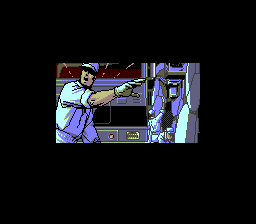Retro Replay Review
Gameplay
Kidō Keisatsu Patlabor delivers a layered RPG experience built around the daily duties of Tokyo’s SV2 unit. At its core, the game unfolds on a strategic map of Japan where mission markers pop up to indicate rogue Labor incidents. This macro view invites players to plan their responses, choosing which assignment to tackle first and weighing the severity and potential rewards for each call-out.
(HEY YOU!! We hope you enjoy! We try not to run ads. So basically, this is a very expensive hobby running this site. Please consider joining us for updates, forums, and more. Network w/ us to make some cash or friends while retro gaming, and you can win some free retro games for posting. Okay, carry on 👍)
Once a location is selected, gameplay shifts to a top-down “main” screen where you pilot an AV-98 Ingram mecha. Movement and environmental interaction feel intuitive, with clear terrain indicators and obstacle avoidance. Patrol routes and civilian areas are rendered in crisp pixel art, giving you enough information to navigate complex urban scenarios without overwhelming the small-screen real estate.
Combat unfolds in a dedicated battle screen triggered by the action button. Here you can cycle through an array of melee and ranged attacks, each with its own animation and tactical application. As Noa Izumi and Isao Ota gain experience, they unlock new combos and special moves, encouraging experimentation and strategic loadouts. Uniquely, you also have the option to switch from force to dialogue, attempting to de-escalate conflicts by negotiating with hostile pilots. This “talk” mechanic adds depth, rewarding players who prioritize diplomacy over destruction.
Mission structure blends linear progression with side assignments, so you never feel locked into a single path. Resource management comes into play as you balance repair costs, ammo supplies, and pilot stamina. Difficulty ramps up steadily, demanding careful planning and giving a genuine sense of growth as you master new techniques and refine your approach to each Labor threat.
Graphics
Graphically, Patlabor strikes a nostalgic chord with detailed 2D sprite work reminiscent of early ’90s console RPGs. The Ingram models are faithfully recreated, capturing signature features like the bulky limbs and distinctive helmet visor. Animation frames for punches, kicks, and blasts are fluid enough to convey the weight of metal on metal, even on less powerful hardware.
Backgrounds in urban environments are richly textured, from sprawling cityscapes to cluttered industrial zones. The muted color palette evokes a realistic atmosphere; concrete grays and muted blues dominate, accented by flashing hazard lights and vibrant explosions during combat. Transitional effects—such as screen shakes and brief parallax scrolling—add dynamism to intense battles without sacrificing clarity.
Character portraits and dialogue windows maintain the anime aesthetic with expressive close-ups of Noa and Ota during conversations. Facial reactions during negotiation sequences are surprisingly nuanced, offering subtle smiles or determined frowns that enhance emotional engagement. Although cutscenes are limited to still frames with text, they effectively convey key story beats and keep production requirements in check.
Overall, the graphics balance faithfulness to the Patlabor franchise with technical constraints of the era. While modern gamers might find the resolution modest, the game’s artistic direction and consistent style ensure that each frame feels purposeful and true to the source material.
Story
Kidō Keisatsu Patlabor weaves an episodic narrative that mirrors the tone of the original anime and manga. Each mission functions like a standalone case file, introducing a rogue Labor scenario with its own backstory and motivations. Pilots Noa Izumi and Isao Ota bounce off each other with lighthearted banter, yet the stakes feel real when innocent bystanders are caught in the crossfire.
The script does an admirable job of balancing procedural police drama with personal moments. Between assignments, you can explore the precinct, chat with fellow officers, and sometimes engage in optional side-quests that reveal character depth. These interludes enrich your understanding of the world and provide respite from the adrenaline of combat, making the SV2 team feel like genuine colleagues rather than mere avatars.
Negotiation sequences stand out as a storytelling twist. When you choose to dialogue rather than attack, the conversation trees branch based on prior choices, pilot stats, and contextual clues gleaned from reconnaissance. Successfully defusing a conflict through words not only conserves resources but also unlocks unique rewards and story snippets that highlight the human side of Labor pilots.
Though the overarching plot doesn’t feature a grand conspiracy or epic villain, its strength lies in slice-of-life authenticity. The game respects the source material, delivering modest thrills and emotional payoffs that resonate with fans. Those seeking deep, twist-laden narratives may find it straightforward, but its sincerity and grounded approach to mecha policing set it apart from high-fantasy RPG peers.
Overall Experience
Kidō Keisatsu Patlabor offers a refreshing take on the RPG genre by integrating strategic planning, real-time combat, and diplomacy into a cohesive package. Its pacing is steady, allowing players to absorb each mission’s unique flavor without feeling rushed. Whether you’re dismantling a rampaging Labor or talking down a distressed pilot, variety is built into every aspect of the gameplay loop.
Fans of the Patlabor franchise will appreciate the faithful representation of characters, mecha designs, and thematic tone. Nostalgic touches—such as original voice samples in Japanese and theme-style background music—enhance immersion. Meanwhile, newcomers can enjoy an accessible entry point that rarely assumes in-depth knowledge of the anime’s lore.
Minor drawbacks include occasional lengthy load times between screens and a relatively limited color palette compared to modern titles. However, these technical quibbles pale in comparison to the game’s strengths: a balanced blend of action and negotiation, well-paced character moments, and a warm homage to its source material.
In sum, Kidō Keisatsu Patlabor is a unique RPG experience that marries strategic mecha combat with genuine police drama. Its thoughtful mechanics and steady narrative make it a rewarding choice for both genre enthusiasts and Patlabor fans alike. If you’re looking for a game that values both action and conversation, this title stands ready to patrol your collection.
 Retro Replay Retro Replay gaming reviews, news, emulation, geek stuff and more!
Retro Replay Retro Replay gaming reviews, news, emulation, geek stuff and more!









Reviews
There are no reviews yet.